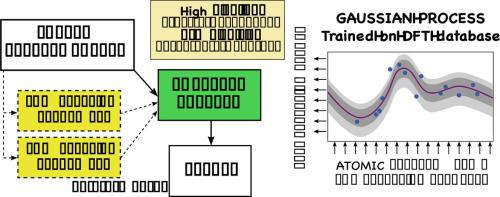Nuclear Instruments and Methods in Physics Research Section B: Beam Interactions with Materials and Atoms ( IF 1.4 ) Pub Date : 2020-10-12 , DOI: 10.1016/j.nimb.2020.09.011 Luca Messina , Alessio Quaglino , Alexandra Goryaeva , Mihai-Cosmin Marinica , Christophe Domain , Nicolas Castin , Giovanni Bonny , Rolf Krause

|
The reliability of atomistic simulations depends on the quality of the underlying energy models providing the source of physical information, for instance for the calculation of migration barriers in atomistic Kinetic Monte Carlo simulations. Accurate (high-fidelity) methods are often available, but since they are usually computationally expensive, they must be replaced by less accurate (low-fidelity) models that introduce some degrees of approximation. Machine-learning techniques such as artificial neural networks can be employed to work around this limitation and extract the needed parameters from large databases of high-fidelity data. However, the latter are often computationally expensive to produce. This work introduces an alternative method based on the multifidelity approach. Correlations between high-fidelity and low-fidelity predictions are exploited to make an educated guess of the high-fidelity value based only on quick low-fidelity estimations, to be used for instance as an efficient and reliable source of physical data for atomistic simulations. With respect to neural networks, this approach requires less training data because of the lower amount of fitting parameters involved. The method is tested on the prediction of ab initio formation and migration energies of vacancy diffusion in iron-copper alloys, and compared with the neural networks trained on the same database.
中文翻译:

DFT驱动的多保真框架,用于构建原子级模拟的有效能量模型
原子模拟的可靠性取决于提供物理信息来源的基础能源模型的质量,例如用于原子动力学蒙特卡洛模拟中迁移壁垒的计算。准确的(高保真)方法通常可用,但是由于它们通常在计算上很昂贵,因此必须用引入一定程度近似度的较不准确的(低保真)模型代替。可以使用诸如人工神经网络之类的机器学习技术来解决此限制,并从大型高保真数据数据库中提取所需的参数。但是,后者通常在计算上昂贵。这项工作介绍了一种基于多保真方法的替代方法。高保真度和低保真度预测之间的相关性被用来仅基于快速低保真度估计就可以对高保真度值进行有根据的猜测,例如,可以用作原子性模拟的物理数据的有效且可靠的来源。关于神经网络,由于所涉及的拟合参数较少,因此该方法需要较少的训练数据。该方法通过预测从头开始形成和扩散铜-铜合金中空位扩散的迁移能,并与在同一数据库中训练的神经网络进行比较。











































 京公网安备 11010802027423号
京公网安备 11010802027423号